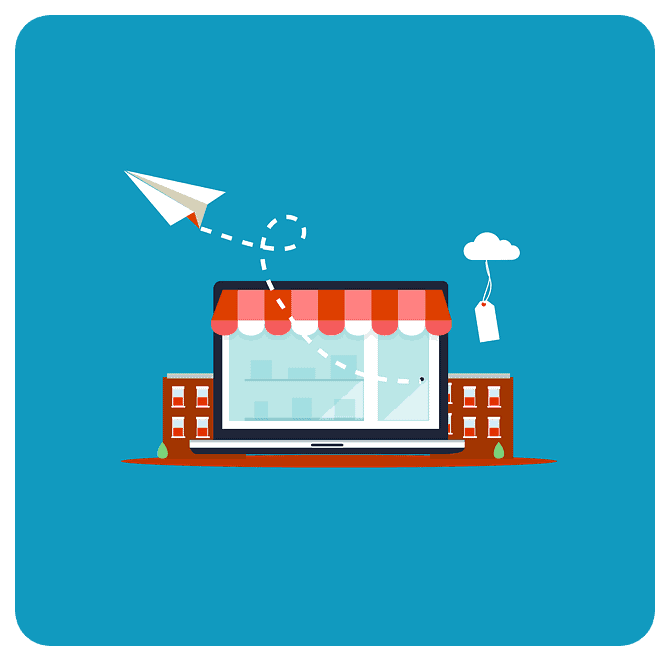Shopify Dropshipping Guide
 You’ve probably heard of the term dropshipping before, and are vaguely aware that Shopify is an online store.
You’ve probably heard of the term dropshipping before, and are vaguely aware that Shopify is an online store.
If you’re reading this, you’ve probably also considered selling a product or many products online, but are worried about how you’re going to deal with inventory and sourcing your products.
Well, luckily when you combine Shopify, an online storefront, with a dropshipping company, you don’t have to worry about much other than marketing and selling your brand and your products.
What is Dropshipping?
 One of the biggest issues that any online store has to deal with is inventory. That means sourcing the product, finding a place to store it, paying for that storage, taking things out of storage to ship, and then packaging it.
One of the biggest issues that any online store has to deal with is inventory. That means sourcing the product, finding a place to store it, paying for that storage, taking things out of storage to ship, and then packaging it.
As you can imagine that tends to require a big workforce, and even if we’re talking about a small store, that’s still probably half a dozen people.
As such, the natural solution to that is to essentially contract that work out to a third party. This means that they handle all the day-to-day work, including finding the products and letting you focus on your main job of selling.
It also allows both of you to take advantage of economies of scale so that rather than having to pay lower individual prices for products and storage, it can be done in bulk.
Third-Party Store
In essence, dropshipping creates a symbiotic relationship, where the drop-shipper lets you do all the selling, usually through an eCommerce platform, and in return, they handle all the inventory and logistics management.
Overall, it’s a win-win situation with only one or two downsides, mainly being that you can’t always pick what products you sell. This means that if you’re planning to sell something unique or with low stock globally, dropshipping might not work very well.
Essentially, you are selling the same products as others since the inventory is set by the drop shipper, so margins are thin and it’s hard to make a name.
That being said, it’s a great way to supplement your product offerings and a way to entice customers to purchase the products you have a better margin on.
What Is Shopify and Why Should I Use It?
 If you’re unfamiliar with Shopify, it’s one of the world’s leading eCommerce platforms, if not the leading eCommerce platform.
If you’re unfamiliar with Shopify, it’s one of the world’s leading eCommerce platforms, if not the leading eCommerce platform.
Essentially it works by providing you the framework to create an online store by giving you tools to easily build and design a website.
On top of that, it has a great framework of payment systems and options, which makes life so much easier for any seller. It also provides other things like inventory management systems, item pages, cart recovery systems, and things of that nature.

So why use Shopify with dropshipping? Because it allows you to create a nearly hassle-free experience when entering the world of eCommerce. Pretty much everything is handled for you in terms of admin and logistics, so all you need to focus on is selling and creating the website using Shopify’s tools.
Shopify also has an app store that allows you to find pretty much any kind of tool you’ll be looking for, whether it’s SEO or analytics, pretty much everything is covered.
Figure out a Niche
 Before actually setting up accounts and picking a dropshipping company, the first thing you really need to do is figure out what type of products you want to sell.
Before actually setting up accounts and picking a dropshipping company, the first thing you really need to do is figure out what type of products you want to sell.
Of course, there’s a lot of different advice out there on how you should approach that choice.
For some, the advice tends to be that you should pick something you’re passionate about. After all, if you really like something, you’ll be much more motivated to sell it, market it, and simply put more effort into the business.
For others, it’s all about the profit, and you should instead pick out products that have a good profit margin and are selling well.
Ultimately, as I alluded to earlier, a mix of both is probably the best. That way you can have a bit of profit while still being driven by something your passionate about.
Picking a Good Product
As for picking profitable products to sell, well that’s a bit more difficult.
One way to go about it is to pick a general category that you have at least a little interest in, such as fashion, health, perfumes, fountain pens, or any topic that has a specific product that is sellable. Then, you’ll want to do some keyword searches to see what people are looking for and what the trends are.
Another interesting idea is to start and build up a mailing list through an email marketing service, where you provide advice and other general content. This will help you build up a potential client base to move over to Shopify once you set it up.
It will also continue to be valuable afterward to help build your base and market your products.
Chose a Dropshipper
![]() Once you have a general idea of what you want to sell, then the next thing to do is pick a drop shipper. Now, since Shopify purchased Oberlo it’s the default dropshipping app on the website and that’s not necessarily a bad thing.
Once you have a general idea of what you want to sell, then the next thing to do is pick a drop shipper. Now, since Shopify purchased Oberlo it’s the default dropshipping app on the website and that’s not necessarily a bad thing.
Oberlo is great for first-timers, especially since it has a free starter plan, no minimum orders, and is great if you have less than 500 products in your store.
If you’re going for printed products, two good options are Printful and Printify. Both sites offer print-on-demand services for everything from shirts to phone accessories and generally have a wide range of products they can print on.
Printful is slightly ahead since it’s based in more locations, but generally speaking, both services are relatively similar, so pick the one that fits your needs the most.
Look For a More Versatile Option
On the other hand, if you’re going for artisanal or top brands, then Modalyst is probably what you’re looking for. Its supplies come from the EU, US, and Ali Express, so you have a ton of options when it comes to what you want to sell.
Whichever drop shipper you pick, make sure you pick one that not only fits your products but also fits the delivery times you’re aiming for. If the drop shipper has warehouses in the US or China, it might take longer to ship, depending on where the buyer is, which is why analytics are important to understand where your client base is coming from.
Dropshipping on Shopify
 Once you’ve settled on a drop shipper, the next thing you’ll want to do is open an account with Shopify. The process is relatively simple, and if you’ve opened accounts on a website builder or WordPress host before, then you’ll be familiar with the steps you need to take.
Once you’ve settled on a drop shipper, the next thing you’ll want to do is open an account with Shopify. The process is relatively simple, and if you’ve opened accounts on a website builder or WordPress host before, then you’ll be familiar with the steps you need to take.
After you’ve created your account and reached your admin panel, you’ll want to add the dropshipping app of choice.
For this, you’ll need to go to the Shopify app store and search for your drop shipper.
Adding Products
Then comes the best part! Go through your dropshipping app of choice, and look for products you want to add. This can be done either by looking through the general categories or by searching for specific items if you already know what you want.
As you find items, you’ll add them to some form of import list (which is the case for Oberlo), which you can then import into your Shopify account. Again, this process is relatively simple and pain-free, so just make sure all the products you want are on your Shopify and you should be good!
Design and Launch your Store
Finally, the most important part is actually setting up the website for your store. Generally speaking, there are a few ways to go about this, but if you don’t have much web-design acumen, don’t worry about it! Shopify has a lot of pre-designed themes that you can pick from that will make your life easier.
Along with the pre-designed themes, you can also pick what segments you want to include or not include, such as featured products, or collections lists. There’s actually a lot of customization you can do at this point to get the site looking exactly how you want it.
If you have experience working with website builders, then again, you’ll be very familiar with this process.
One final thing you’ll need to do before launching your store is setting up a payment system. For this, you’ll need to got Settings then Payment Providers. The default for Shopify is Paypal, but they accept a lot of different payment processing options, and that’s usually divided by region.
After you’ve selected your payment process, you’re done! All you need to do now is launch your site, and your online store is ready for customers to come and (hopefully) buy.

